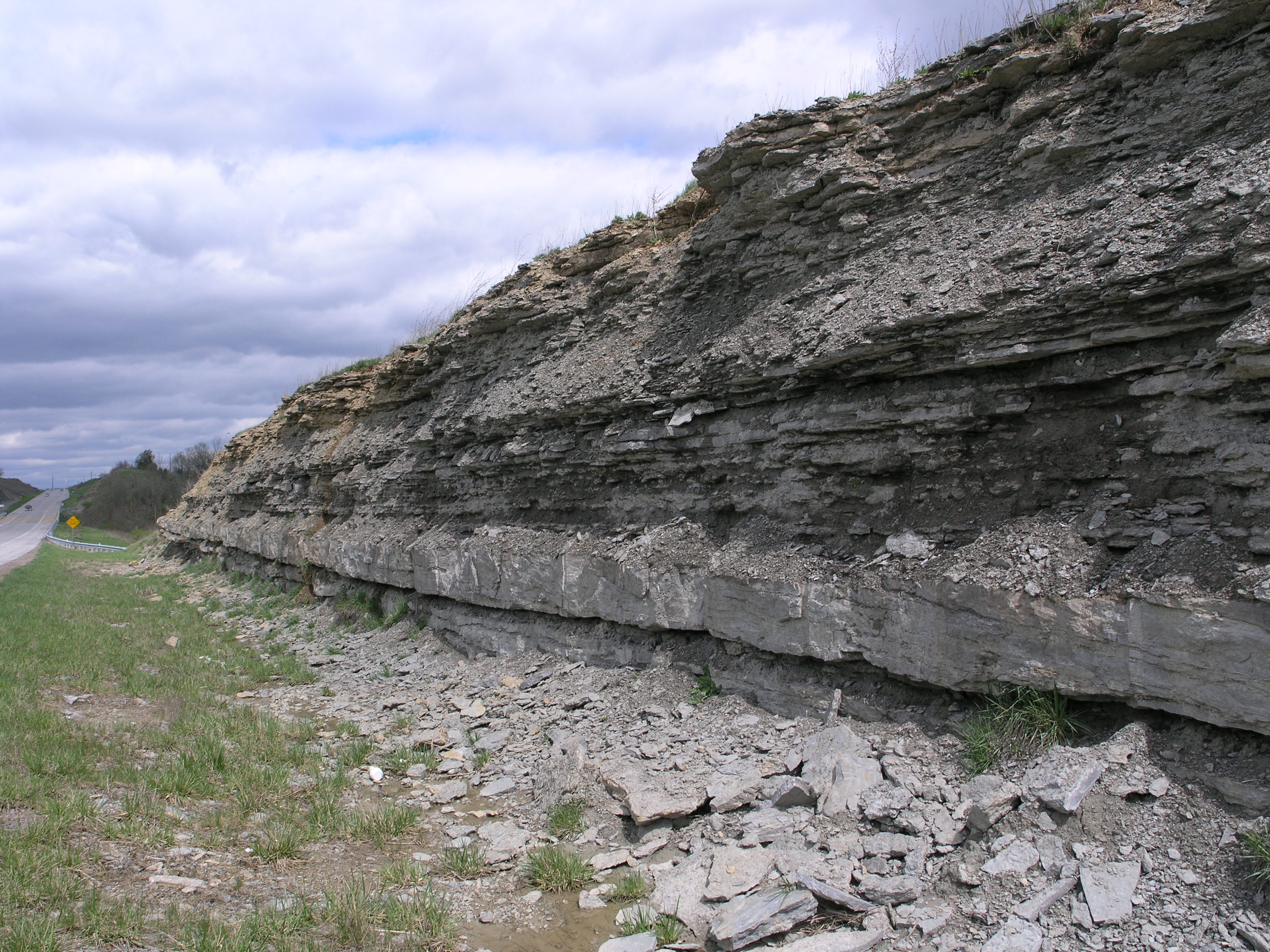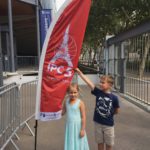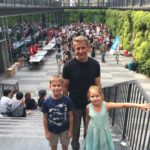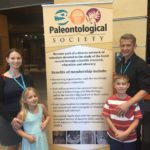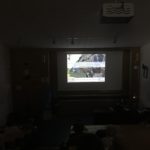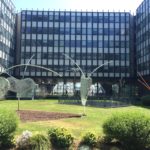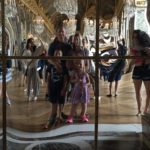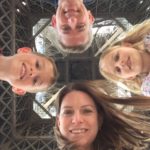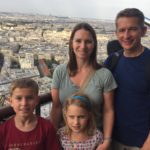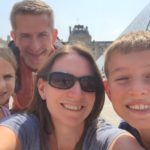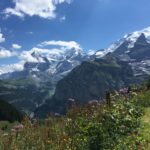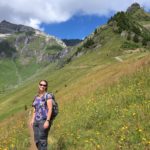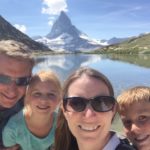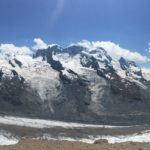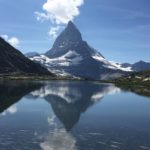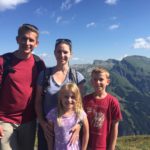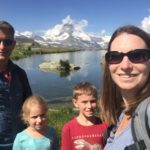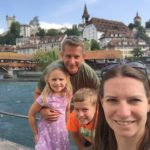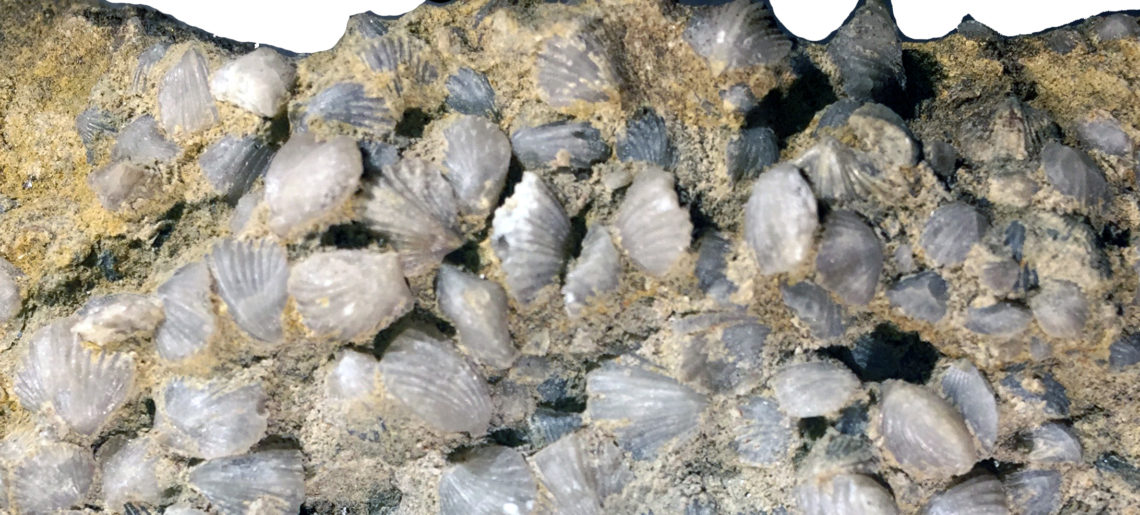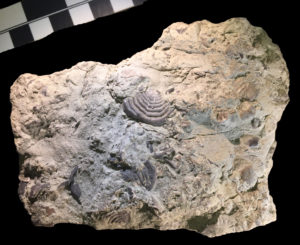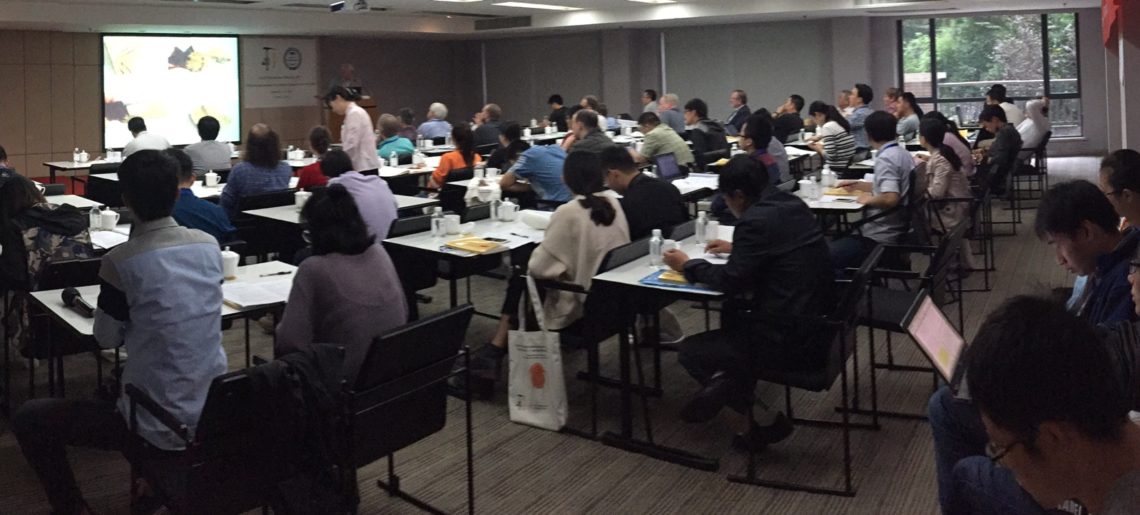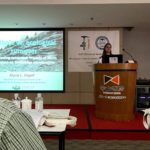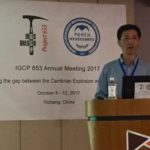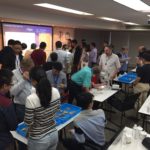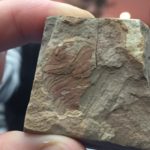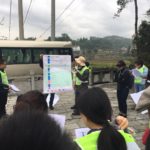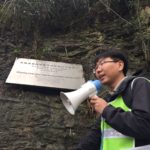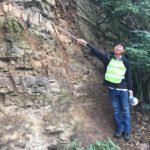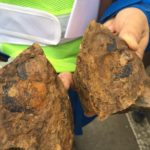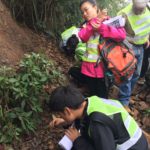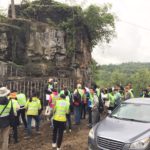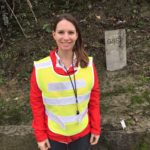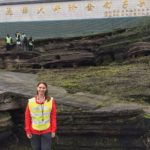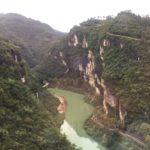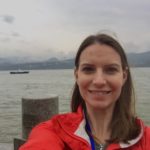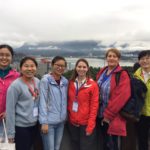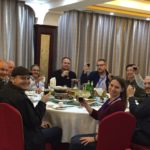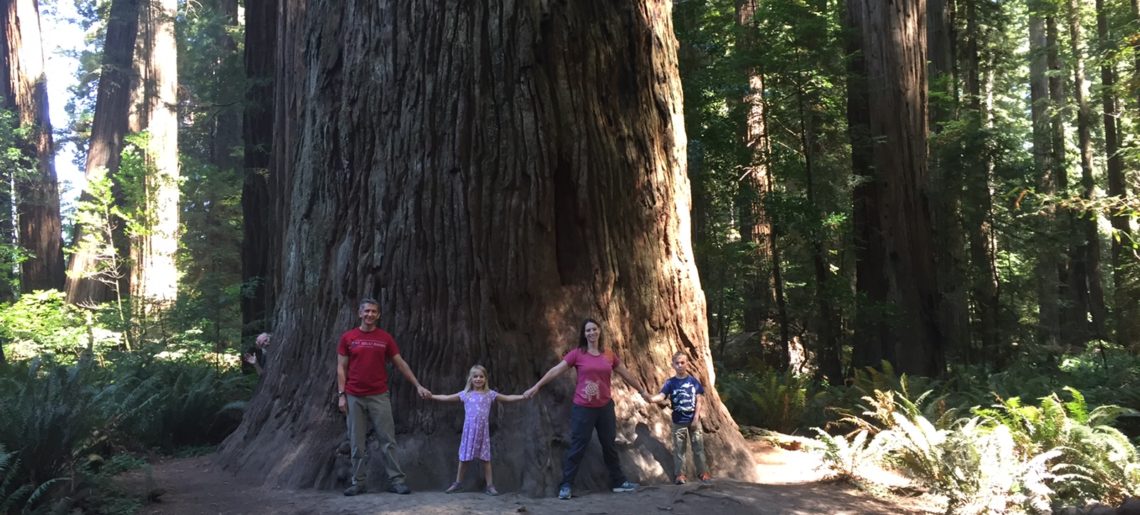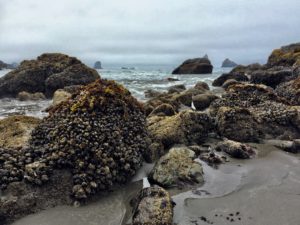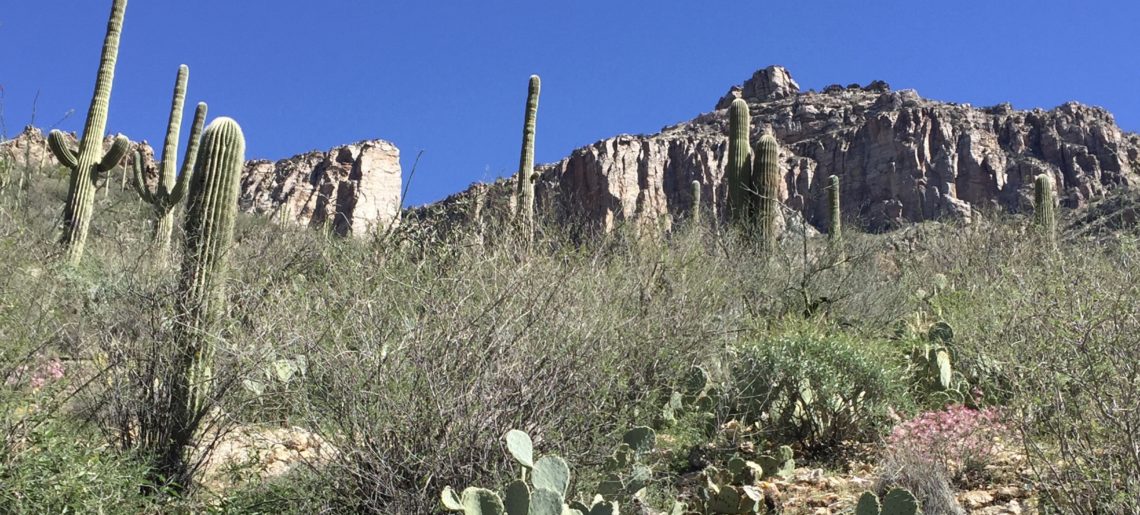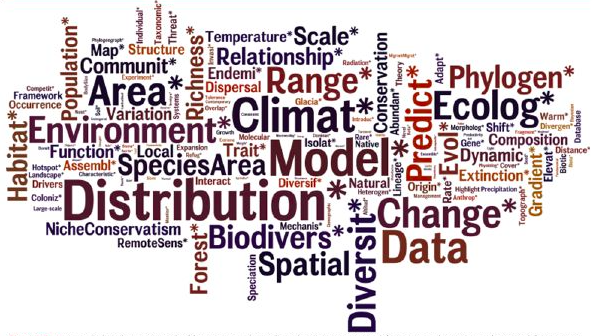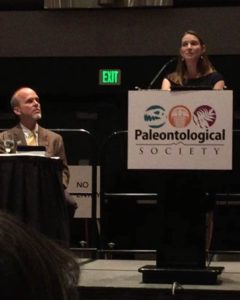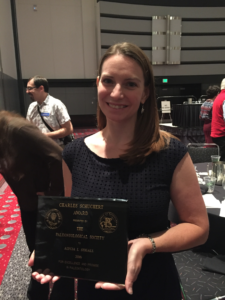Congratulations to Shaolin! Shaolin received a Schuchert and Dunbar Grants in Aid Award to fund a research trip to study the brachiopod collections at the Yale Peabody Museum. Notably, this award is named in honor of Charles Schuchert, a brachiopod worker who hailed from Ohio and produced foundational work on Ordovician brachiopods. As part of her thesis project, Shaolin will study some of Shuchert’s own specimens while investigating phylogenetic and biogeographic patterns of Ordovician brachiopods and speciation patterns during the Great Ordovician Biodiversification Event.
5th International Palaeontological Conference = Family trip to Europe!
The main meeting for me this summer was the International Paleontological Conference in Paris, from July 8-12th. Dan and I typically attend the IPC meetings (prior conferences included IPC3 in London in 2010 and IPC4 in Mendoza, Argentina in 2014). These are really broad international conferences with the potential to meet with international colleagues that we don’t see at the Annual GSA meetings.
Due to the timing of this year’s meeting, we decided to take our kids for their first European adventure. So spent a week in Paris to attend the conference and explore then a week in the Swiss Alps. It was a really fantastic plan! A very nice mix of European capitals and amazing nature. The kids can’t wait to go back!
Here is a write up I did for Ohio University:
OHIO Paleontologists Stigall, Hembree Present in Paris – Ohio University | College of Arts & Sciences
Ohio University paleontologists Drs. Alycia Stigall and Daniel Hembree, both professors of Geological Sciences, presented at the 5th International Paleontological Congress in Paris (IPC5), France in July. The IPC5 is the largest gathering of professional paleontologists globally, and this meeting included more than 1,000 participants from around the world. All …
And some of my favorite photos:
IGCP 653 Synopsis and Photos
Here is my longer, formal report about all the exciting things that happened as part of the IGCP 653 meeting.
Annual meeting synopsis and photos | IGCP 653
The main Annual Meeting of the IGCP 653, titled “Trekking Across the GOBE (Great Ordovician Biodiversification Event): From the Cambrian through the Katian”, was a great success. The main meeting on the Ohio University campus, brought together a group of 60 scientists from eight nations. Read the Ohio University writeup here.
IGCP 653 Annual Conference
In my role as co-leader of the IGCP 653 project, I have a variety of jobs. One is the social media/website/communications/membership director for the project. Another is to convene occasional symposia at meetings, like this one that I co-led with Rebecca Freeman at 2017 Annual GSA meeting in Denver. The most significant role so far, however, has been to organize the IGCP 653 Annual Meeting at my home institution, Ohio University.
Planning an international conference is a complex endeavor, and I spent substantial amount of the 2017-2108 academic year planning everything from the meeting website, meeting rooms, banquets, housing, arranging catering, acquiring grant support, printing name tags, producing the abstract volume, developing shuttle schedules to move participants from the Columbus airport to Athens, identifying volunteers to run field excursions, and then helping them with logistics, plus managing the finances of the entire system. Needless to say, it was a tremendous effort, and the support of my co-organizers (especially Dan Hembree!) and the students workers during the meeting week was critical to success.
Overall, the meeting went very well. We welcomed over 60 scientists from 8 countries to Athens. The pre-conference excursion to the late Cambrian through Middle Ordovician strata of Great Basin of Utah and Nevada was spectacular, and the mid- and post-conference excursions to Kentucky were outstanding. Everyone went home with plenty of brachiopods–and some other fossils, perhaps–and a greatly improved understanding of the stratigraphy, geochemistry, paleontology, and other facets of the Great Ordovician Biodiversification Event.
It was extremely rewarding to welcome my colleagues to campus after months of planning. I learned a great deal in the process and was able to get to know some amazing people much better than I otherwise would have if it wasn’t my meeting. However, I will also be very pleased to be an attendee and not an organizer for the foreseeable future.
Geological Sciences Hosts International Conference on Campus – Ohio University | College of Arts & Sciences
Ohio University hosted the Third Annual Meeting of the International Geoscience Programme (IGCP) 653 in June. This conference, titled “Trekking Across the GOBE (Great Ordovician Biodiversification Event): From the Cambrian through the Katian” brought together a group of 60 scientists from eight nations. Participants engaged in three days of scientific …
Science—what am I up to anyway?
It’s occurred to me that I have been writing quite a bit about broadening participation in science lately and have not actually talked much about what science I have been up to. So here is a brief update about recent developments on that front.
At the IGCP 653 meeting in Yichang, China, I presented new research on some very interesting and rare fossils from the lower part of the Cincinnatian Series. Over the past few years, I have been very fortunate to receive a series of rare fossils collected by some of the fantastic amateur paleontologists of the Dry Dredgers in Cincinnati, Ohio. In particular, Ron Fine, has collected some intriguing brachiopods from the lower Cincinnatian Kope Formation (Edenian Regional Stage) that look like they belong to lineages otherwise only known as invasive taxa from the upper Cincinnatian (Richmondian Regional Stage). These pre-Richmondian “invaders” comprise an interesting set of species that shed light on invasion dynamics in the fossil record.
At Yichang, I argued that interbasinal species invasions (or immigrations) could be considered in a hierarchical context, with ranks including ephemeral invasion, incursion epibole, and biotic immigration events. I am currently expanding this invasion hierarchy into a full article for Annual Reviews in Ecology and Evolutionary Systematics. (AREES), so I won’t elaborate here, but I think this is a really exciting and potentially transformative concept about the assembly of diversity through time.
At the GSA meeting in Seattle, I am presenting research related speciation mechanisms and how we can move from a basic correlation of diversity with Earth systems events to a causal mechanism for increasing diversity based on the process of speciation. Much of the arguments for this talk are in press already within my Lethaia paper (here).
So…for the near term, these are the scientific questions that I am investigating and the questions that keep me up at night: how do we really resolve speciation processes in the fossil record, how can we use that information to understand diversification during the Ordovician Radiation/Great Ordovician Biodiversification Event, and how do invasions (of varying intensities) contribute to diversity patterns of life through time?*
*obviously these questions are best addressed with data about articulated brachiopods from the Ordovician Period
IGCP 653: Yichang Reflections
I’m currently on a 12 hour flight from Shanghai to Chicago as part of my 3 flight (and 29 hour) itinerary home from the 2nd Annual IGCP 653 meeting in Yichang, China. I can say, unreservedly, that this was a fantastic meeting!
Attendees included more than 60 delegates from 10 nations. The fact that most attendees were Chinese—and I am not—provided a wonderful opportunity for me to meet many new and upcoming scientists—both students and early career professionals that I have not previously had the opportunity to interact with. I was so impressed by the quality of their science and their ability to communicate at a high level on an international stage. What a talented group of young scientists! I am incredibly encouraged and inspired by them.
Of course, I was also able to reunite with (and meet new) colleagues from Europe, Africa, and North America as well. Truly this meeting met the spirit of UNESCO, our funding agency for the IGCP project, in terms of bridging international divides and fostering common interests and collaborations.
At this conference, provocative scientific ideas were espoused—generating substantial discussion, important geologic sections were visited (including the GSSPs for both the Hirnantian and Dapingian stages!), and cultural differences were both explored and celebrated. It’s exciting both how much we have learned about the Great Ordovician Biodiverisfication Event in terms of ocean chemistry, oxygenation patterns, diversity patterns of metazoans and also how much we have to learn—such as when did this event start and end, whether such things can be clearly defined, and what does that mean for the Earth system?
Speaking for myself, my favorite parts were probably the fact that we had an international assemblage of brachiopod workers to talk with (it’s great-and rare to be among people that love my favorite fossils as much as I do!) and that there were so many dynamic young female researchers in the group.
As anyone who is relatively close to me knows, I am very concerned with increasing participation in science on both a national and international level. I was so encouraged to see so many young and dynamic female scientists! Female students earned awards for both poster and oral presentations. This is pretty groundbreaking.
To place this in context, I had a conversation with a colleague, who I generally admire very much as a scientist, in which he said to me one evening {I’m paraphrasing} “You know, we always try to hire men instead of women for permanent jobs. You can’t say that in open meetings, but in secret meetings, we always say this.” I asked why this was the case and was told that it could be problematic for women to both be in charge of or be the majority of a field team to remote regions. I pushed back on this concept (I certainly was told the similar things as a grad student), and my friend said “Well, most women are not like you. They are not assertive and independent.” On one level, I was glad that my colleague appreciated that some women could be leaders, but it also made clear to me that there are many countries where women still need to fight hard to be considered scientific equals. I am not special. Female scientists need the chance to grow and shine and deserve the same support as our male colleagues.
The male student at our table noted that the female students work much harder and achieve higher levels of excellence than the male students. He sees the value in this contemporaries, and I am heartened that over time this view will win out…but I’d much rather we achieve equity in the near term and not wait 20 years and lose out on the great science these young women could have done by excluding them.
I hope that my work in the international community can help to foster a sense of empowerment for female (and other underrepresented) scientists in both the USA and other nations. At this meeting, I was assertive. I capitalized on my leadership as a co-chair of IGCP 653 role to be present, to chair sessions, to judge and present awards, to invite everyone to Athens, Ohio in 2018, and I hope that seeing one woman do that in a sea dominated by male leadership can help to inspire the fantastic and talented women that I met at this meeting to be assertive and empowered in their own scientific lives.
- ZHAN Renbin opens the meeting
- Guole Biota workshop
- Guole Aglaspidid
- Hirnatian GSSP
- Hirnatian GSSP
- Hirnatian GSSP
- Hirnantia itself
- Hirnatian GSSP
- Floian reef
- Dapingian GSSP
- Dapingian GSSP
- Three Gorges Region
- Yangtze River
- At Three Gorges Dam
- Conference banquet
- Yichang City
ESA: Invasive species and climate change plus geotourism
This summer was relatively quiet on the travel front. We had a family vacation in May to Disney World (for which I over-prepared with substantial data analysis using the myDisney App), but otherwise both Dan and I were in Athens for the summer doing analyses and writing rather than in the field collecting new data. It was really lovely!
Our Ohio sojourn ended in August, when I traveled to Portland, Oregon to participate in the annual Ecological Society of America (ESA) meeting as an invited speaker for a session about the combined impacts of invasive species and climate change on modern ecosystems organized by Cascade Sorte and Bethany Bradley. ESA is a wonderful meeting and a great chance to simultaneously catch up with my biogeography colleagues and engage with a different segment of the scientific community than I usually do. So I was quite pleased to present about my work on fossils and the lessons we can learn from that for modern environments. I had the opportunity to catch up with some of my Quaternary paleoecology colleagues and have some really insightful and educational discussions with modern biology colleagues during the meeting.
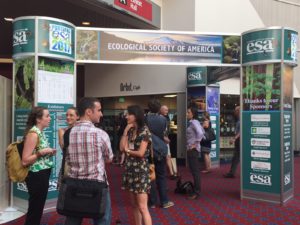
On it’s own, ESA was very good meeting, but the best part of the trip was that Dan and the kids joined me at the conference as part of a two week volcanoes & coasts road trip. As geologists, Dan and I were excited to have the chance to visit some really exciting National Parks and also to show the kids “real” (=geologically young) mountains for the first time. We love the Appalachians, but western geology is so spectacular.
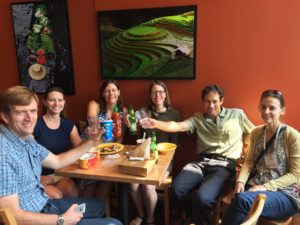
In the end, we put over 1000 miles on the rental car. We visited Mt. St. Helens, Mt. Rainier, Crater Lake, Oregon Caves, the Jedediah Smith State Park (=Redwoods!), Orgeon Dunes, a series of state parks with tidepools along the Oregon Coast, and the Newport Aquarium. It was a spectacular trip. Mt. St. Helens was amazing and emotional.
The boat trip on Crater Lake was a real highlight. The kids LOVED climbing on the fallen Redwood logs, exploring the tidepools, and the marmots on Mt. Rainier. Overall, it was super. Maybe too much driving, but I don’t think I would have cut out any of the places we visited. It’s really fun to geek out on geology with my family who also loves geeking on geology. The kids earned four junior ranges badges along the way—they are definitely right up there with their parents as nature lovers.
Reflections on the International Biogeography Society Meeting in Tucson: Celebrating diversity and deep time
This post was initially written as a guest blog for the International Biogeography Society blog
The International Biogeography Society Biennial Conference is one of my favorite meetings to attend. These conferences consistently profile outstanding and cutting edge science, opportunities to interact with a set of colleagues that I don’t have the opportunity to see at my paleontology-centric conferences, and interesting destinations to explore. This year’s conference in Tucson hit the mark in all areas.
A key strength of IBS conferences is that they are fundamentally a celebration of diversity in many ways: diversity of approaches ranging from molecular to big data and ecological to phylogenetic frameworks; diversity of focal ecosystems and taxa; diversity of temporal lens from modern to deep time; diversity of nationalities and cultures; diversity of genders and identities. This diversity makes the scientific contributions and opportunities so much stronger. Developing such a diverse conference is not a coincidence, the IBS board and meeting organizers actively work to promote scientific and culture diversity. And the dedication and hard work pays off. For example, someone like me, who studies paleobiogeography of marine life from 400 million years ago feels at home with colleagues studying geographic structure of genetic variation in modern tree species.
From my perspective, two aspects of this year’s IBS conference particularly struck me: the increasing inclusion of a deep time perspective and fossil data and increasing recognition and participation of women in biogeography.
Each of the symposia featured at least one talk involving paleodata. The “Modeling large-scale ecological and evolutionary dynamics” symposium featured paleo data in nearly every talk and showcased a wide range of paleo data from historical records to the Pleistocene. Contributed sessions, posters, and mini-talks also prominently focused on the relevance of paleodata, including analyses that employed Paleozoic data to address questions relevant to modern biodiversity concerns (abstract book here).
Geologic and paleontological data, particularly the breakup of Pangaea and the waxing and waning of the Pleistocene ice sheets, have long been incorporated in biogeographic analyses. What was exciting about this meeting is the fact that paleodata beyond those two cases are being employed and being employed broadly within the field in many different contexts ranging from species distribution models, quantifying community functioning and species richness processes, and calibrating projections of biotic impacts of future climate changes.
Rising above this pervasive paleontological mist was the fact that the winners of the MacArthur & Wilson and the Alfred Russell Wallace Awards, Jessica Blois and Margaret Davis, are paleobiogeographers, which further underscores the significance that the field ascribes to research emphasizing fossil data.
Both awardees are also women, which leads to my second point. This meeting celebrated the accomplishments of outstanding women in biogeography, like Jessica and Margaret, and at the same time acknowledged and celebrated the additional hurdles and barriers that were (and still are) faced by women in science. Steve Jackson, in his citation of Margaret Davis, provided a wonderful discussion that contextualized some of the hurdles that Margaret faced as the sole women in pollen analysis, the significance of her indomitable spirit, and the inspiration she has provided to others.
Today, women are not usually alone in our departments or subdisciplines, but we and members of other underrepresented groups still face obstacles, additional requests on our time as token representatives, and implicit bias in reviews and in other contexts. But meetings like IBS, where a group of women met at 7:30 am over coffee to discuss shared issues and plan a support group and where we have lunch mentoring groups that discuss early career issues, provide clear and positive steps forward.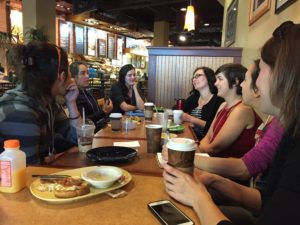
Women have been leaders in biogeography for many years, as evidenced by the Margaret Davis’s well deserved Wallace award, and women are poised to continue leading and innovating, as evidenced by female students winning 3 of 5 poster awards.
I ended the conference by raising my glass with a group of a dozen female paleobiogeographers. For me it was a fitting end to a conference that celebrated diversity of science, of timescales, and of individuals.
New paper showcasing current trends in biogeography
My colleagues and I recently published a horizon scan, a review of the current state of the field, of modern biogeography based on the International Biogeography Meeting held in Bayreuth, Germany in 2015. Some of the key threads in this paper are the increasing prominence of large databases, integrated analyses, and inclusion of paleodata.
Dawson, M.N., Axmacher, J.C., Beierkuhnlein, C., Blois, J., Bradley, B., Cord, A.F., Dengler, J., He, K.S., Heaney, L.R., Jansson, R., Mahecha, M.D., Myers, C.E., Nogués-Bravo, D., Papadopoulo, A., Reu, B., Rodgríguez-Sánchez, F., Steinbauer, M., Stigall, A.L., Tuanmu, M-N. & Gavin, D.G. 2017. A Second Horizon Scan of Biogeography: Golden Ages, Midas Touches, and the Red Queen. Frontiers in Biogeography, 8(4), e29770. Online
It’s great to have this paper out, and just in time to revisit this concepts and explore how the field has changed at the upcoming International Biogeography Meeting in Tucson, Arizona next month.
Geological Society of America Reflections
It is difficult to describe this year’s GSA meeting in Denver. Overall, it was a great meeting, full of the usual pride in my students’ accomplishments, joy of reuniting with colleagues including many Stigall Lab alumni, nervousness about my own talks, and thrill of learning about the newest developments in the science of paleontology. But I will always remember this meeting for the Paleontological Society banquet.
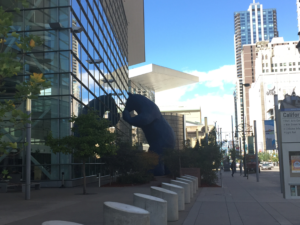
The Stigall lab was busy presenting cutting-edge science on a wide variety of topics. Current MS students Ranjeev Epa and Nilmani Perera gave excellent poster presentations about Oligocene freshwater gastropods from Tanzania and Pennsylvanian marine community ecology of Ohio, respectively. Recent alumnus Sarah Trubovitz gave a talk about her MS work on Ordovician brachiopod paleoecology, and I spoke about the importance of alternating dispersal and vicariance regimes in biodiversity accumulation.
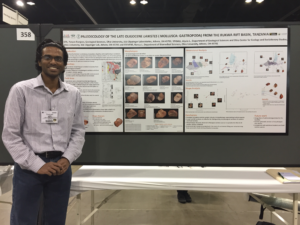
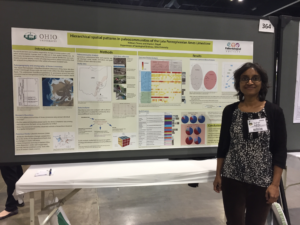
We had a great Stig*Allstars (=name my alumni gave themselves) dinner to kick off the meeting. Getting together with this talented group of former students turned colleagues is always a highlight. They are doing such amazing work as PhD students and early career scientists. I’m so very proud of them and excited to see where their careers will go.
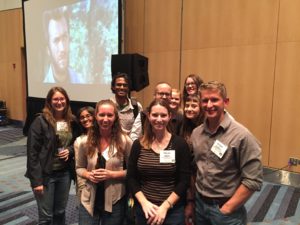
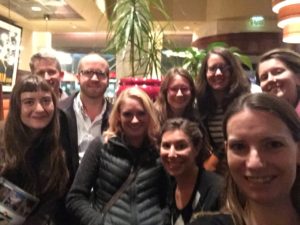
This year’s GSA, however, was really special as I was awarded the Charles Schuchert Award for Excellence and Promise in Paleontology from the Paleontological Society. This was the 45th time the Schuchert Award has been presented. It was only the 5th time that a woman received the award, and the first time a woman with children was the recipient. After receiving the award from the Paleontological Society president, Steven Holland, I was honored to be able to give a short acceptance speech to the nearly 400 paleontologists gathered at our annual banquet. I focused my remarks on the challenges to women and minorities in paleontology alongside the standard series of thank you’s. This the first time that increasing participation has been addressed specifically in an award speech, and I felt both very compelled and nervous about making these comments. I am very glad that I did! Continuing to engage in conversations about women and minority challenges are very important for continued progress in our (or any) discipline.
The full text of my speech is below, and it will eventually be published in the Journal of Paleontology.
RESPONSE BY ALYCIA L. STIGALL
For the Charles Schuchert Award, 25 September 2016Thank you, Bruce, for your generous words. I deeply thank the Paleontological Society for recognizing me with this honor. I truly am very grateful and humbled to be selected as the 2016 Schuchert Award recipient. As a brachiopod worker from Cincinnati, the Charles Schuchert award holds special significance to me. I am also deeply honored to now be included among the prestigious set of 44 prior awardees. It is particularly gratifying as I am only the fifth woman to receive this award, and first woman who was a mother at the time of the award.
I am extremely thankful to be a paleontologist today. Paleontology is becoming an ever more inclusive and collaborative science. As I look out from this podium, I see a wonderful diversity of paleontologists –diversity of scientific approaches, diversity of focal taxa, diversity of gender, diversity of ethnicities and nationalities. Our diversity makes our discipline stronger.
However, barriers to full and equitable participation in science for women and minorities remain considerable. Implicit bias, higher expectations, under recognition, harassment, and isolation remain substantial concerns. As a society and as individuals, we are taking positive steps to increase dialog, foster support groups, promote awareness, and tackle our own inherent biases. Like all women who continue in science, I have overcome such challenges in my career, but tonight I stand here excited and optimistic that the future of our discipline will be one of ever increasing inclusion.
I would not be here tonight without the support of my family, colleagues, and friends, and I’d like to take the rest of my time to recognize some of them. First I must thank my parents. As teachers, they have been steadfast in their support of my love for learning, rocks, and fossils. When I was a child, they took me to national parks in 47 states, they accompanied me to rock and mineral shows, gave me a copy of a 1962 Golden Guide to Fossils, and allowed me to disappear into the nearby stream to hunt fossils for hours at a time. Those early experiences surrounded by loving support gave me the confidence to truly pursue my goals and dreams.
As an undergraduate at the Ohio State University, I had the amazing good fortune to learn morphology and systematics (with a Swedish accent) from Stig Bergström who taught me the importance of deeply understanding a clade and of adopting promising new approaches during one’s career. Loren Babcock instilled in me a sense of boundless enthusiasm for prehistoric creatures. And Bill Ausich taught me how to be an excellent scientific citizen, the importance of loving your clade, and above all pursing excellence in science. I am so thankful for the enduring support of Bill and Stig, which has been instrumental in my development as a scientist.
I graduated from OSU with a career goal to resolve early arthropod phylogeny–but quickly reoriented my research interests to studying the complex impacts of biogeography and ecological change on macroevolutionary patterns. In graduate school at the University of Kansas, I worked on phyllocarid crustacean phylogenetics of my master’s thesis, but rapid realized the limitations of working on uncommon fossils for my research agenda. So I shifted my focal taxon to rhynchonelliform brachiopods, and I haven’t look back. (Although I greatly enjoy working with conchostracans from time to time) Brachiopods are truly awesome.
Throughout graduate school, Bruce Lieberman was amazing mentor in every dimension of the word. He taught me how to construct a project, how to succeed in publications, and the importance of perseverance. Even beyond graduate school, Bruce’s promotion of my career has been immeasurable, and I thank him very deeply.
In my twelve years at Ohio University, I have been privileged to work with very supportive colleagues in our Geological Sciences department, an immensely talented set of paleontologists sprinkled across campus, and fantastic collaborators in the Patton College of Education. Working in a department with the master’s as our terminal degree offering, I’ve had the distinct pleasure of working very closely with each of my graduate students. My greatest scientific joy has been mentoring and encouraging my students—now numbering 13—as they develop from scientific novices to confident, accomplished scientists conducting research publishable in top journals. I am very proud of them, and certainly wouldn’t be standing here before you tonight without this exceptional group of students turned collaborators, many of whom are here to support me tonight.
Although I did not know many women paleontologist as a student, I have benefitted greatly from knowing and learning from many amazing women as a professional. In particular Margaret Fraiser, Sandy Carlson, Brenda Hunda, Lisa Park Boush, Dena Smith, and Peg Yaccobucci have been co-conspirators and role models in various ways. I thank the women who trailblazed in the cohorts ahead of mine, and I am greatly inspired by the women in the junior cohorts behind me.
I also thank my colleagues outside of this room. My approach to science has been considerably broadened and enriched by collaborations with modern biogeographers and ecologists as well my international colleagues with whom I’ve studied fossils on all seven continents.
Finally, and most importantly, I must thank my husband, Dan Hembree, who has been my partner in this journey since our first day of graduate school at Kansas. He has always believed in me, even when I did not. His friendship, laughter, encouragement, and discussions have made my science and my life so much richer, and I can’t imagine either without out him. Lastly, our children Max and Josie make everything awesome. It has been invigorating to re-explore the wonders of fossils through their young eyes.
Thank you again, to the members and Council of Paleontological Society for this recognition. I will strive to fulfill the promise inherent in this award and serve our community well in the years to come.

